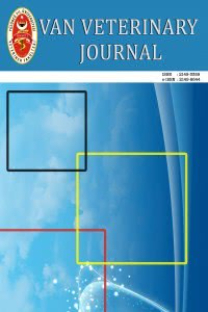Hindi lenfoid organlarında (Timus, ve Bursa Fabricius) yaşa bağlı olarak mast hücrelarinin dağılımı
mast hücreleri, yaş, fabricius kesesi, lenfatik sistem, hindi, dalak, kümes hayvanları, heterojenlik
Age-related distribution and heterogeneity in the number of Mast cells lymphoid of the organs in Turkey
mast cells, age, bursa fabricii, lymphatic system, turkeys, spleen, poultry, heterogeneity,
___
1. Arda M (1994): İmmunolojik Reaksiyonlarda Fonksiyonları olan Diger Hücreler. Immunoloji. Medisan Yayınevi, 170-172.2. Bancroft JD, Cook HC (1984): Manuel of Histological Techniques, Churchill Livingstone Inc. New York.
3. Böck P (1989): Romeis Mikrokopische Technik, 17. aufl. Urban und Schwarzenberg, München, Wien, Baltimore.
4. Eren Ü, Astı RN, Kurtdede N, Sandıkçı M, Sur E (1999): The Histological and Histochemical Properties of the Mast Cells and the Mast Cell Heterogeneity in the Cow Uterus. Turk. J. Vet. Anim. Sci., 23: 193-201.
5. Enerback L (1966a): Mast Cells in Rat Gastrointestinal Mucosa: I. Effects of Fixation. Acta Pathol. Microbiol. Scand., 66: 289-302.
6. Enerback L (1966b): Mast Cells in Rat Gastrointestinal Mucosa. II. Dye-Binding and Metachromatic Properties. Acta Pathol. Microbiol. Scand., 66: 303-312.
7. Huntley JF (1992): Mast Cells and Basophils: A Review of their Heterogeneity and Function, J. Comp. Path., 107: 349-372.
8. Karaca T, Yörük M (2004): A Morphological and Histometrical Study on Distribution and Heterogeneity of Mast Cells of Chicken’s and Quail’s Digestive Tract. YYÜ. Vet. Fak. Derg., 15(1-2):115-121.
9. Karaca T, Yörük M and Uslu S.: Age-Related Changes in the Number of Mast Cells in the Avian Lymphoid Organs. Anat. Histol. Embryol. (In Press).
10. Kendall MD (1980): Avian Thymus Glands: A Review. Dev. Comp. Immunol., 4: 191–209.
11. Kendall MD, and Clarke AG (2000): The Thymus in the Mouse Changes its Activity During Pregnancy: A Study of the Microenvironment. J. Anat., 197: 393-411.
12. Majeed SK (1994a): Mast Cell Distribution in Mice. Arzneimittel-forsch., 44(10): 1170-1173.
13. Majeed SK (1994b): Mast Cell Distribution in Rats. Arzneimittel-Forsch., 44(3): 370- 374.
14. Mekori YA (2000): Lymphoid Tissue and the Immune System in Mastocytosis. Hematol. Oncol. Clın. N., 14(3): 569-577.
15. Pearce FL (1986): On the Heterogeneity of Mast Cells (Current Review), Pharmacol., 32: 61-71.
16. Sainte-Marie G, Peng FS (1990): Mast Cells and Fibrosis in Compartments of Lymph Nodes of Normal, Gnotobiotic, and Athymic Rats. Cell Tissue Res., 261: 1-15.
17. Saglam M, Astı RN ve Özer A (1997): Genel Histoloji, Genisletilmis 5. Baskı, Yorum Basın Yayın Sanayi Ldt. Sti., Ankara.
18. Sanchez-Refusta F, Ciriaco E, Germana A, Germana G, Vega JA (1996): Age-Related Changes in the Medullary Reticular Epithelial Cells of the Pigeon Bursa of Fabricius. Anat. Rec., 246(4): 473-80.
19. SAS (1998): Uses’s Guide: Statistics, Version 12.0 Edition. SAS Inst., Inc., Cary, NC.
20. Strobel S, Miller HRP and Ferguson A (1981): Human Intestinal Mucosal Mast Cells: Evaluation of Fixation and Staining Techniques, J. Clin. Pathol., 34: 851-858.
21. Wang T (1991): Mast Cells in Chicken Digestive Tract. II. Fixation, Distibution, Histochemistry and Ultrastructure, Tokai J. Exp. Clin. Med., 16(1): 27-32.
22. Wight PAL (1970): The Mast Cells of Gallus Domesticus, Acta Anat., 75: 100-113.
23. Wight PA, Mackenzie GM (1970): The Mast Cells of Gallus domesticus. II. Histochemistry. Acta Anat. (Basel)., 75(2): 263-75.
24. Zoller M (1990): Intrathymic Presentation of Nominal Antigen by B Cells. Int. Immunol., 2(5): 427-34
- ISSN: 1017-8422
- Yayın Aralığı: 3
- Başlangıç: 1990
- Yayıncı: Yüzüncü Yıl Üniv. Veteriner Fak.
Serum zinc, copper and thyroid hormone concentrations in heifers with retarded growth
İHSAN KELEŞ, Nurcan DÖNMEZ, NURİ ALTUĞ, EBUBEKİR CEYLAN
Hindi lenfoid organlarında (Timus, ve Bursa Fabricius) yaşa bağlı olarak mast hücrelarinin dağılımı
Turan KARACA, MECİT YÖRÜK, SEMA USLU
Nutrient and botanical composition of pasture in Ceylanpınar Agriculture Farm
MEHMET AVCI, OKTAY KAPLAN, Mugdat YERTÜRK, MUSTAFA ASLAN
Dose dependent effectiveness of topical selamectin on puppies with ascaridiosis
Nazmi YÜKSEK, NURİ ALTUĞ, ABDULLAH KAYA, Tevfik Zahid AĞAOĞLU, Yaşar GÖZ, CUMALİ ÖZKAN
